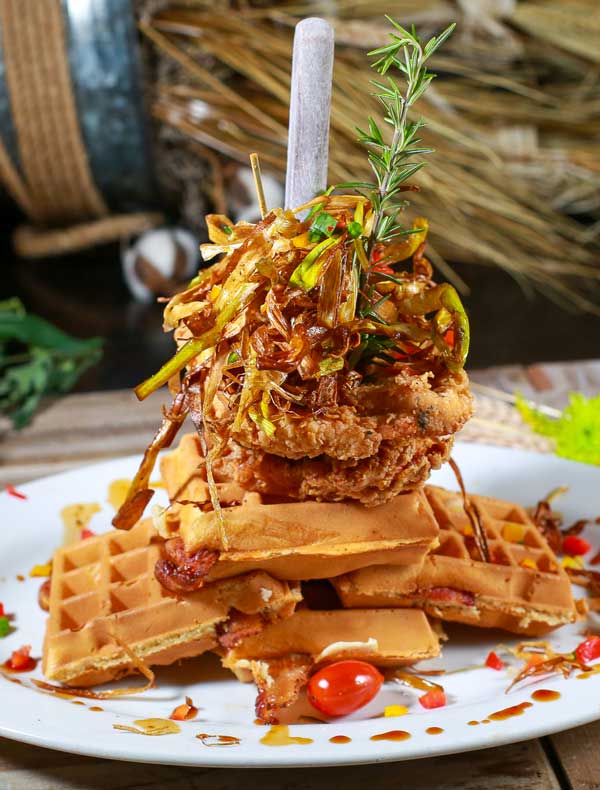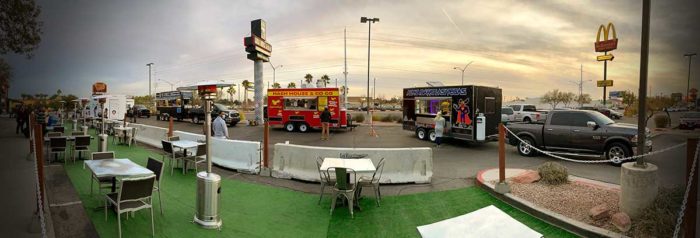Summary — Opening a new restaurant brings business owners plenty of excitement and uncertainty, but even more so with a nation in lockdown. Learn how creativity and a little food truck magic helped keep one newly-launched Las Vegas restaurant location and it's staff on the "Go Go".
Time to read: 8 minutes

When times got tough Hash House thought ‘outside of the box’
After 16 years spent building up a loyal clientele, refining their concept and expanding into markets across the country, the partners running Las Vegas’ venues for restaurant chain Hash House A Go Go felt confident about opening another Vegas location. They signed a lease on the new place in February 2020.
“Turns out, opening a new 7,000-square-foot location in the middle of a pandemic isn’t the greatest idea,” laughs Jim Rees, the Hash House partner and COO who manages operations for the chain. “We had to shut it down for a while and get back to basics. But all three of the partners are very hands-on participants in running the restaurants, and across our employee base there is a culture of personal connection with the company, and that’s been very important.”
 Tractor-Wheel Pancakes & Sage-Fried Chicken
Tractor-Wheel Pancakes & Sage-Fried ChickenHash House A Go Go got its start in Southern California, based on recipes that the original founder learned in his grandmother’s kitchen in Indiana: traditional Midwestern fare in massive proportions, with a “twist” wherever possible — a little something to give each dish a hook. The chicken is “sage fried,” the burgers are stuffed, and the pancakes are the size of a tractor’s steering wheel.
“Twisted Farm Food” is the catch phrase, And when Jim and his partners brought the concept to Las Vegas, it took off. “The concept works very well in casinos,” he explains. “Big value, large portions. It’s not fast casual or fine dining. It’s its own thing. Small-town Indiana, traditional things from the Midwest. It’s a brunch concept in a lot of ways, but we also serve dinner. And we build from our weekends. Our concept attracts a lot of tourists, and that got us into a number of other cities.”
When the COVID-19 pandemic hit and the “Temporarily Closed” signs went up, the partners faced a number of challenges. These included immediate cashflow issues, getting stuck with an incredible amount of food, and figuring out a viable and sympathetic way to manage some-650 employees across all of their restaurants. “We emphasized that we would keep paying insurance, and we helped them transition to unemployment. We really worked at staying in touch with them,” Jim says. “It was a struggle to keep them on our side. But we knew we’d need them back.”
We really worked at staying in touch with [our employees]. It was a struggle to keep them on our side. But we knew we’d need them back.
— Jim Rees, Hash House Partner and COO
Well before the pandemic, Hash House A Go Go had been increasing employee communications, building a sense of community, playing up birthdays, anniversaries, pins and other service commemorations. When the world fell apart, they doubled the effort and employee communication became a major HR task.
“We wanted to create a culture that could compete with the casinos and hotels where they are just a number, and this just placed more weight on that,” Jim says. “The [Hash House] concept helps with employee loyalty, as does the food, both the quality and the quantity. They set it down and customers go, ‘What is this? Wow!’ It makes the employees proud and it makes their jobs easier.”



“Twisted farm food” served in over-sized proportions in warm and inviting spaces. Las Vegas-based Hash House A Go Go has character and flavor in spades.
With all of the excess inventory and incoming food they’d committed to, Hash House restaurants started hosting “Free Food Fridays,” serving 2,500 free takeout meals each week with the help of employee volunteers and vendors chipping in. During a time when many hospitality people suddenly found themselves out of work and struggling financially, a free meal was especially meaningful. And as you’d expect, people remembered. Many of those who benefitted from “Free Food Fridays” later came to work for the restaurant, or came back as paying customers when their situation improved.
But even when the doors reopened, capacity was limited to 35 percent inside. For most restaurants, that was not going to be sustainable. Hash House adjusted in many little ways, including using these three ideas any restauranteur could add to their playbook:![]() Modified Menu: Reinventing and sharpening their menu to improve on the cost-side, while continuing to delight customers with culinary creativity.
Modified Menu: Reinventing and sharpening their menu to improve on the cost-side, while continuing to delight customers with culinary creativity.
“There’s so much you can do with a good menu analysis,” Jim explains. “We went from a ten-page menu down to two pages, and massively improved our cross-used ingredients. Turned out that 80 percent of what we were selling was not the key stuff. If it’s [a choice between] getting rid of that massive menu or not surviving, it’s what you do. And we had absolutely zero negative response from guests.”
Reducing weeknight dinners actually helped with the menu reduction for Hash House, too. But even into the summer, reports that restaurants around the nation were struggling to fill open positions and get back to pre-pandemic staffing levels was a common headline. Smarter scheduling became a must-do for many.
![]() Thinking Outside: Expanding their outdoor footprint with patios and food trucks to meet people where they were most comfortable.
Thinking Outside: Expanding their outdoor footprint with patios and food trucks to meet people where they were most comfortable.
As with much of the country, Vegas and other Hash House cities were great about allowing outdoor seating expansions. Less parking but more dining is a perfectly fine trade-off. As for the food trucks, they had already gotten their feet wet with a “Hash House 2 Go Go” concept. The pandemic meant it was time to go all-in. In Vegas, they began holding food truck roundups on Thursdays at the parking lots of their standalone locations, and invited other local operators—tamale, shrimp, barbecue and dessert trucks were all regulars—to form outdoor food courts. It became an event, and proved so popular they quickly added Tuesdays.

Coincidentally, Jim is very active in the Nevada Restaurant Association (NvRA) and was the previous past-president. He helped organize the association’s lobbying of the governor and legislature to be as restaurant supportive as possible during the various stages of the quarantine.
According to Katherine Jacobi, the current president of the NvRA, Jim also helped members secure everything from PPE to PPP to private funding. “Jim was a real leader, and he understood that the voices of individual operators would resonate louder with the politicians and public than our association statements ever could,” she says. “He really stood up for our industry and community.”
EMPLOYERS also works with the NvRA to provide support for restaurants and businesses who serve the hospitality industry in Nevada, including important restaurant employee relief efforts. Find out more about our workers’ compensation insurance benefits and how becoming an NvRA member can help provide support, advocacy and more to Nevada restaurants, like Hash House a Go Go, and others in the hospitality and service businesses.
Check out a few of Jim’s most memorable takeaways, listed below.

Hash House COO Jim Rees offers key insights gained during the pandemic.
![]() “HR is an extremely important part of keeping the staff in tune with what’s going on,” Jim says. “For example, letting them know about [COVID] testing, and how we would handle it. Capacity limits and pacing. Knowledge gives them a sense of control.”
“HR is an extremely important part of keeping the staff in tune with what’s going on,” Jim says. “For example, letting them know about [COVID] testing, and how we would handle it. Capacity limits and pacing. Knowledge gives them a sense of control.”
![]() “Training has taken on a whole new aspect. Getting food out easier and faster makes things easier and more efficient [for our staff]. And that’s a win for the customer and the business, as well.”
“Training has taken on a whole new aspect. Getting food out easier and faster makes things easier and more efficient [for our staff]. And that’s a win for the customer and the business, as well.”
![]() Maintaining an active voice for the community and working with fellow restaurant owners put pressure on the government to do right by the industry and its employees. “This was about more than just us as a business,” Jim explains. “And sometimes the good guys do finish first.”
Maintaining an active voice for the community and working with fellow restaurant owners put pressure on the government to do right by the industry and its employees. “This was about more than just us as a business,” Jim explains. “And sometimes the good guys do finish first.”
New to workers’ compensation insurance? EMPLOYERS has been helping protect small businesses for over 100 years. These workers’ comp explainer resources can help get you started, or if you have questions, connect with a local agent today. If you’re already part of the EMPLOYERS family, current policyholders and agents can log in to EACCESS for account details and more online.